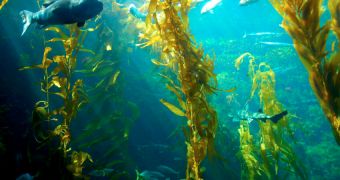The new Kelp Watch 2014 initiative will help researchers understand the extent to which radiation released by the Fukushima Daiichi nuclear power plant, in Japan, has spread across the Pacific Ocean, and along the California coast. The scientific campaign has already started, and should produce its first results soon.
The work is being carried out by researchers with the US Department of Energy's (DOE) Lawrence Berkeley National Laboratory (Berkeley Lab) and colleagues from the California State University in Long Beach (CSULB). Their campaign will center on studying kelp populations in California.
Kelp is a group of large seaweeds or algae that contains about 30 genera, and live in groups called forests at shallow depths in the ocean. They grow very fast in warm and nutrient-rich water, and can easily assimilate chemical contaminants in their vicinity. They can essentially be used to keep track of how ocean chemistry changes at their locations.
For this investigation, researchers will focus on gathering giant kelp and bull kelp samples from various locations around the California coasts. The work was initiated by Steven L. Manley, a CSULB biology professor, and Kai Vetter, the head of Applied Nuclear Physics at Berkeley Lab.
“The California kelp forest is a highly productive and complex ecosystem and a valuable state resource. It is imperative that we monitor this coastal forest for any radioactive contaminants that will be arriving this year in the ocean currents from Fukushima disaster,” Manley explains.
He adds that his idea for Kelp Watch 2014 came after receiving a large number of calls and emails from Californians and visitors, asking about the effects of the nuclear meltdown at Fukushima on the marine wildlife and ocean safety in California.
“I tell them that the anticipated concentrations that will arrive are most likely very low but we have no data regarding its impact on our coastal ecosystem. Kelp Watch 2014 will provide an initial monitoring system at least in the short-term,” the investigator explains.
Several nuclear reactors at the Fukushima facility were heavily damaged by the March 11, 2011 earthquake that struck Japan, creating massive tsunami waves and widespread devastation. The magnitude 9 tremor killed thousands and left countless people without a place to live.
According to the research group, Kelp Watch 2014 will start in mid-February, and will conclude sometime during early winter. A total of 19 academic and government institutions and universities around the country are also involved in this large-scale effort.
“What I have attempted to do is to organize marine scientists and educators from up and down the coastline to collect a large amount of kelp several times a year so that we can ascertain the amount of radioactive material entering our kelp forests,” Manley concludes.

 14 DAY TRIAL //
14 DAY TRIAL //